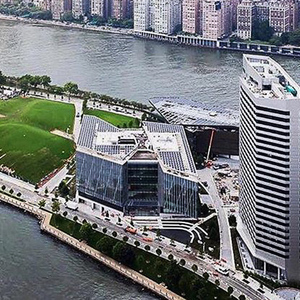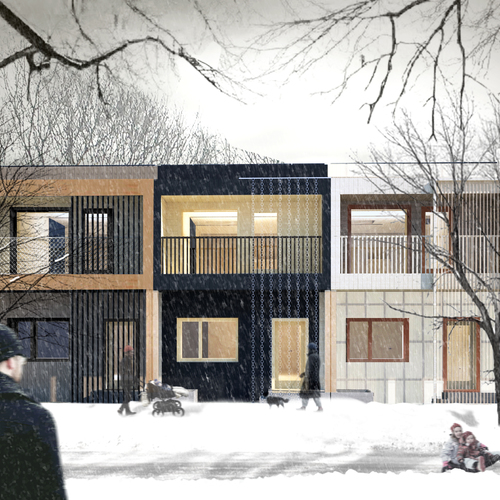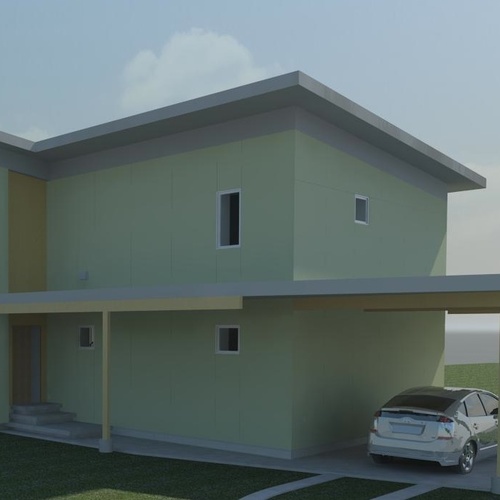Image Credit: Katrin Klingenberg
Image Credit: Katrin Klingenberg In a heating-dominated climate (left), daily temperature swings (represented by the solid red line) are far enough away from the interior thermal comfort zone that static energy models are accurate enough. In a cooling/mixed climate (right), the picture is far more complex. Dynamic, whole-building energy modeling is more appropriate when daily temperature swings fluctuate around the interior comfort zone. (Slide credit: Hartwig Kuenzel, Fraunhofer IBP) The graphs illustrate how the sensible heat ratio decreases if the building envelope is improved for the climates of Beijing and Hong Kong. (Slide credit: Hartwig Kuenzel, Fraunhofer IBP)
Editor’s note: This is the second installment of a two-part blog series. The first installment was Passive House in China, Part 1.
The 3rd China Passive Building Summit in Shanghai was followed up by a one-day expert meeting and workshop. The workshop participants rode out together to the Old Town of Shanghai, a nice area of the city consisting of mostly low-rise buildings. The fall weather had finally turned a little nippy and drizzlier than the days before, and I was happy to have worn my jacket that day.
Shanghai is unique: for two months out of the year (one each in the spring and fall), the temperatures are on the cool side, requiring no cooling and almost no heating. But the humidity is still too high to be comfortable.
The workshop was organized by Passive House Alliance China and took place at a high-performance multifamily retrofit project located in a high-end gated community. Upon our arrival, we were welcomed into a beautifully designed lobby where refreshments were being served to the invited stakeholders — representatives from the construction industry and building science field from different cities in China.
Weekly Newsletter
Get building science and energy efficiency advice, plus special offers, in your inbox.
Following lunch, we had the opportunity to tour several high-performance apartments and begin to delve deeper into high-performance construction methods in mixed/humid climates, with a focus on the cities in the Yangtze Delta. The main focus was on large-scale multifamily buildings, a rather typical and ubiquitous building typology throughout China.
Humidity is the real problem
If China and the U.S. are climate twins, then Shanghai is a close twin to Houston and southeast Texas, except that Shanghai gets a little bit more rain. The most important challenges for passive design space conditioning in these cities are not the thermal loads but the humidity.
Thermal loads are easily reduced to very low peaks by using passive design strategies such as moderate amounts of insulation (4 inches of mineral wool for a larger scale building will suffice), balanced ventilation with very good energy recovery efficiencies, excellent windows (double-pane with thermally broken frames), and Passive-level airtightness. But the high humidity load from ventilation during summer and the shoulder seasons can only be reduced so far. A significant dehumidification load remains, often during seasons when little or no cooling is required, as was the case while we were in China.
Improvements to the building envelope to minimize heating and cooling peaks also affect the ratio of sensible to latent cooling loads; the latent load becomes equal to or larger than the sensible load. While in less efficient buildings the sensible load far exceeds the latent load and can be taken care of by traditional cooling equipment, in highly efficient passive buildings it is the latent load that is now equal to the sensible load or even dominant. (See examples from Beijing and Hong Kong in the graphs shown in Image #3, below). This poses a new challenge for low-load comfort systems.
Striking the right balance between heating and cooling
Climate-specific targets also matter a great deal. In mixed climates, the right balance between heating and cooling targets becomes critical to avoid over-insulation and overheating. Window performance needs to strike the right balance as well in order to avoid increasing cooling loads inadvertently. Windows need to be optimized for both cases, heating and cooling, to perform at their best.
In the climate of Shanghai, as mentioned previously, good double-pane windows with a lower solar heat gain coefficient and thermally broken frames are typically the right choice to meet comfort targets and to avoid contributing to overheating. Accurate assessment of internal gains must take into account culture, lifestyle, occupancy, and other factors as they have a significant impact on the overall energy balance of high-performance passive buildings.
In the case of China, for example, cooking plays a major role in the country’s vibrant lifestyle and culture, as we were lucky enough to experience first-hand as our gracious hosts showed us the best and most interesting dining spots around Shanghai. Food is central to the culture, and if folks are cooking a lot of flavorful and spiced foods in their homes in a climate with significant cooling loads, they will want directly vented kitchen exhaust hoods.
Grease, odors, and heat need to get captured and thrown out right at the source. I was impressed to see a novel solution to this problem as we toured the retrofitted apartments. Each unit had two kitchens: one being the “real kitchen” with the big stove, prep area, and fridges which were separated from the main living space by sliding doors to minimize the negative indoor air impacts on the rest of the apartment; adjacent to this kitchen was an open kitchen concept with a bar for entertaining! What a brilliant idea (if you can afford it).
The role of energy modeling
Now, what about energy modeling? We have often said that more complex climates really should be modeled using dynamic whole building energy balancing tools such as WUFI Plus. What makes the climate more “complex”? Cooling and dehumidification is needed when the exterior temperature gets closer to the interior comfort zone and begins to fluctuate around it. The warm season is dominated by diurnally reversing heat and moisture flows — inward during the cooler nighttime, and outward during warmer daytime temperatures. Add moisture into this back-and-forth and the situation becomes really complex.
To be able to predict accurately how components and the whole building will perform from an energy and hygrothermal perspective, the designer really needs to perform a dynamic whole-building energy model based on hourly data to make the right choices. In contrast, in a heating-dominated climate, exterior temperatures are swinging far enough away from the interior thermal comfort zone so that heat and moisture flows are mostly flowing out. Static models are accurate enough for simpler climates such as this.
Hygrothermal wall performance checks should be best practice for passive designs in mixed/humid climates to avoid any kind of condensation risk. As China ramps up its energy efficiency efforts in varying climates to near passive building levels and experiments with materials, it will be critical that these models are created. Project teams might not be familiar enough with risk management in mixed/humid climates just yet, which can lead to critical and significant failures.
Impressive performance
Now, what about the high-performance apartment tour? Where are the Chinese at with their high-performance solutions today?
I was thoroughly impressed with what they had already in place in terms of execution, performance, details, mechanical solutions, and, to top it all off, a standardized monitoring interface centrally located in the home to provide constant feedback on thermal comfort and indoor air quality, including levels of fine particulate matter (PM 2.5) and inside-to-outside air quality comparisons. In Shanghai it is often the case that outdoor conditions are worse than indoors due to high pollution levels.
The project we toured was a retrofitted five-story brick building that had been upgraded by adding a 4-inch layer of exterior mineral wool insulation, an airtight layer, and a new clay tile façade. The reported tested air-tightness result was 1.5 ach50, which is very respectable for a retrofit! Space conditioning was solved in a very elegant and most comfortable way: a separate energy recovery balanced ventilation system with appropriate filtration and dedicated integrated dehumidification took care of controlling ventilation humidity loads and outdoor pollutants (as evidenced on the screen of the monitoring interface in the living room; see the photo at the top of the page).
Space conditioning was handled by a separate point-source solution consisting of hydronic heating and cooling integrated into the room’s ceiling. Radiant heating and cooling is a more costly, yet very comfortable, high-end solution. Controlled infiltration and humidity loads are key to this solution to avoid condensation. So is awareness by the homeowner. They need to be put on notice that they can’t cool the home and leave the beautiful lift-and-slide high-performance balcony door open at the same time!
The developer reported that the passive house approach works financially for them for the high-end market. As you might expect, two bedroom apartments were selling in the millions, as would be the case for similar real estate in any other cosmopolitan global city.
Can Passive go mainstream in China?
If I may offer my personal prediction: The Chinese have taken a surprising global lead in fighting climate change and have identified aggressive conservation goals for buildings as a valid strategy. The government has passed mandates to local jurisdictions to find appropriate cost-effective solutions.
If China addresses the cost optimization of passive building measures based on varying climates, construction paradigms, and energy costs in China (similar to what PHIUS did in the U.S.), then they should certainly be able to generate design guidelines aimed at presenting the most economical path to zero. At the rate China is going, I expect it will bring Passive building to the mainstream before he U.S. does because they have the political will, effective materials and components, knowledge of building science and energy modeling, and cost-effectiveness strategies to get there.
What about the state of typical mainstream construction in China?
From what we saw, most apartments in Shanghai already have their own air-to-air heating and cooling heat pump unit sitting on their balcony. Pair that common solution with good airtightness, balanced energy recovery with dedicated dehumidification, moderate amounts of insulation and appropriate hygrothermal wall design, good windows, and you are there.
It would be great to see China taking the lead!
Katrin Klingenberg is the executive director of the Passive House Institute U.S. This post was first published at the PHIUS website.

















0 Comments
Log in or create an account to post a comment.
Sign up Log in